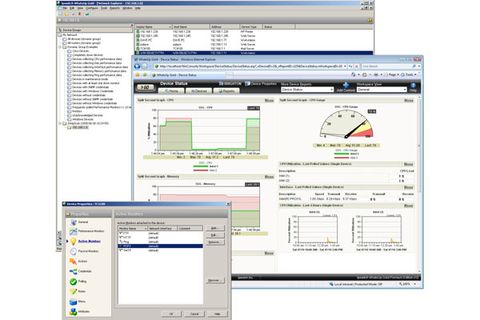Passive monitors reduce network overhead as they listen for device events and advise WhatsUpGold, which will then carry out the associated action. Three types of passive monitors are available, which watch out for SNMP traps and examine Syslog messages or Windows event logs. As with active monitors, WhatsUpGold maintains libraries of monitors containing common types but it's easy enough to add your own.
Actions are associated with active and passive monitors and carry out predefined tasks automatically when a device's status changes. At their simplest level an action can activate a warning sound or pop up window on the console but there are a lot more to choose from as you can run programs or scripts, send messages via email, SMS, pager or beeper and restart selected services. From the selected device's properties you choose which monitors you want to attach, assign an action to each one and decide how long the device or service has to be down before the action is activated.
The web browser interface enables the console to be accessed remotely and provides a very slick interface. This incorporates workspaces enabling you to customise views to include multiple graphs and device status information. There are plenty of choices as you can add graphs covering time periods up to 30 days and select from performance monitors for CPUs, disks, memory, network interfaces and so on.
Reporting has been beefed up as well with an extensive selection on offer from the web interface. Logs are provided for all monitors so you can see easily which ones have had actions triggered and you can compare performance statistics for group members. When comparing, for example, CPU or disk utilisation for a group, hovering the pointer over the individual hardware component pops up a graph showing its activity for the selected time period. Data can be exported to text files or to Excel although an option for converting to PDF would be useful.
The new Split Second Graphs feature adds real time graphs, charts and gauges to the workspace and these include the Windows Task Manager. The workspace can be organised easily using drag and drop and the new InstantInfo provides a pop up display with a precise value when the mouse pointer is hovered over a workspace element. More insight into a device's status can be gained by placing graphs for historical and real time data alongside each other.
There are plenty of choices for network monitoring software but this latest version of WhatsUpGold looks to be pulling away from the field. It is capable of delivering a wealth of device monitoring data in a well designed interface and the Premium version has benefited from a heap of new features making it more appealing to larger networks and as well as SMBs
Verdict
WhatsUpGold has traditionally been seen as an SMB network monitoring product but this latest version moves the bar up as it offers a lot of features well suited to mid-range networks. The Premium version adds valuable application monitoring capabilities, Cisco devices come into the frame and the freshly designed web interface and its workspaces make it even easier to use.
Processor: 2GHz or faster Console: Windows XP SP2, Vista SP1, Server 2003 SP1 Memory: 1GB of RAM Hard disk: 256MB free hard-disk space
Dave is an IT consultant and freelance journalist specialising in hands-on reviews of computer networking products covering all market sectors from small businesses to enterprises. Founder of Binary Testing Ltd – the UK’s premier independent network testing laboratory - Dave has over 45 years of experience in the IT industry.
Dave has produced many thousands of in-depth business networking product reviews from his lab which have been reproduced globally. Writing for ITPro and its sister title, PC Pro, he covers all areas of business IT infrastructure, including servers, storage, network security, data protection, cloud, infrastructure and services.


